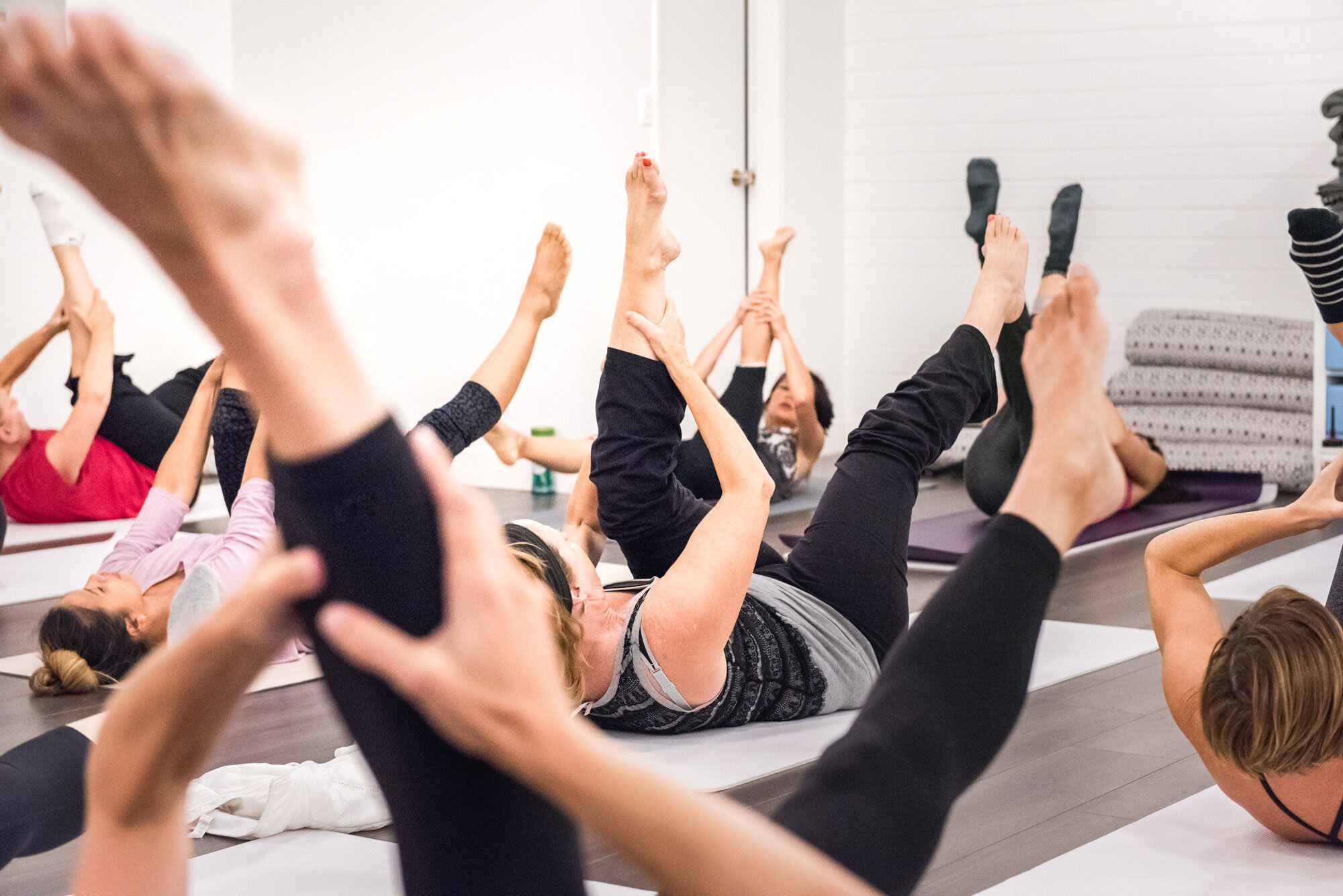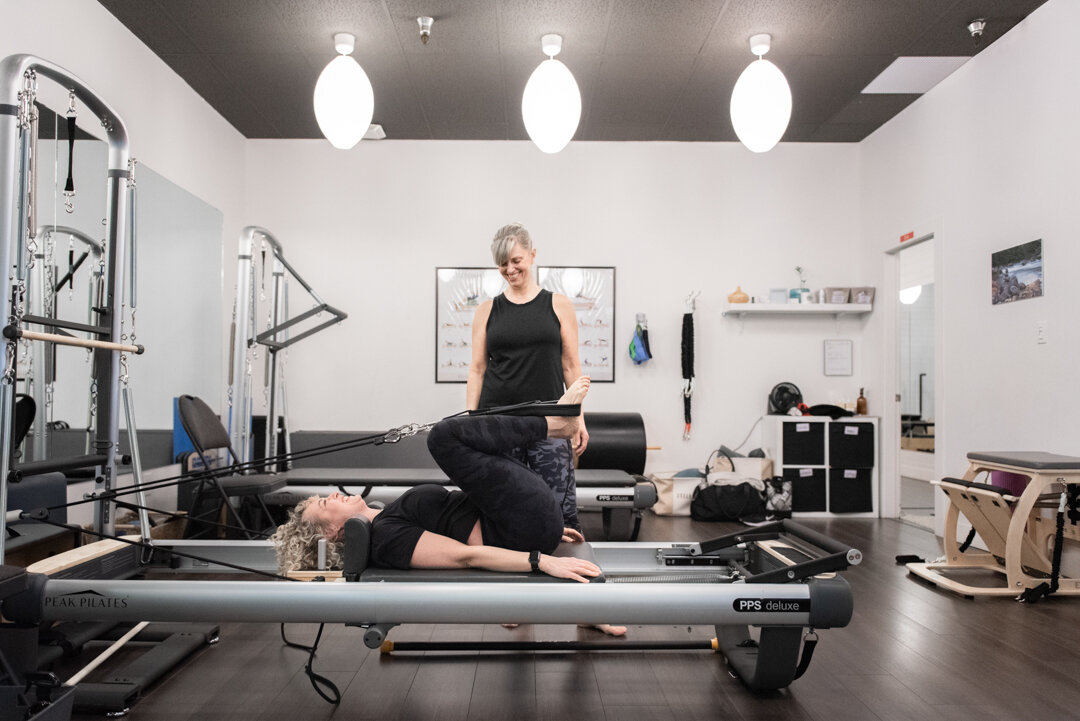FAQs
What’s the difference between Pilates Mat and Pilates Apparatus?
Pilates mat is a system of exercises done on a mat in a group setting much like you would see in a yoga class. The focus is on conditioning the body from the inside out, learning how to engage the deep intrinsic musculature of your core and lengthen and strengthen your spine by moving it in all directions in every class. Mat work is the foundation for all Pilates and we highly recommend developing a mat practice prior to moving onto the equipment. In fact, in classical Pilates, it is often required that you complete the basic level of mat before moving onto apparatus. We don’t have that same requirement at Mindful Movement because we have many people with disabilities or physical limitations that would prevent them from being able to participate in a mat class, however, we do highly encourage this practice when possible.
The Pros:
You can do it anywhere! All you need is a mat.
Its generally less expensive than apparatus.
The Cons:
If not done correctly there is more susceptibility to injuries.
Not recommended for those who have difficulty getting up and down off the floor or for rehab purposes unless in a one-on-one private class.
Pilates apparatus is comprised of a combination of equipment, the reformer being the most widely known and used because of its versatility. The other pieces of equipment that make up apparatus are: The Cadillac or Tower system, The Stability Chair, The Ladder Barrel, Spine Corrector and Arc Barrels.
The beauty of the apparatus equipment is that your body will be attached to springs and pulleys while you are moving it, thus strengthening your body while it’s being stretched. As mentioned above, another benefit of the apparatus equipment is it can be useful for those who have difficulty getting up and down off the floor. Your body can remain supported throughout an entire class so this can be a perfect solution to those with injuries and disabilities.
Pros:
Almost everyone, regardless of age, physically shape or disability can move on the apparatus. We have a range of clients from people with M.S, Parkinson’s and severe RA to elite and professional athlete and every one of them notices a huge improvement in their function
Cons:
It’s more expensive because of the small class sizes and individualized attention
What’s the difference between Pilates and Yoga?
While there are some similarities between Pilates mat and Yoga, there are also vast differences. The main being Pilates on the apparatus. In many ways, where the apparatus is concerned, Pilates is physiotherapy in motion. Using the apparatus we have the opportunity to work specifically with a body’s imbalances and misalignments. For example the apparatus can be used to work the body unilaterally (one side at a time) to correct muscular and postural imbalances and bring symmetry into the body.
In general, the focus of Yoga is more centered around flexibility, breath work and some aspects of meditation or mindfulness. And while Pilates also focuses on these things, there is a deeper focus on learning how to engage the deep, intrinsic musculature of the body, thus often adding an aspect of rehabilitation.
I strongly believe the two complement once another. If you’re not sure what’s right for you I’ve written a more extensive blog on this subject which you can read here.
Will Pilates help me lose weight?
The short answer is, possibly. For any weight loss program to be effective, 80% needs to come from the food that you are eating and 20% comes from the exercise. So combining Pilates with a healthy eating plan will definitely help you achieve a longer and leaner physique. If you need help with the dietary strategies, we have excellent people we can refer you to.
Why is Pilates more expensive than typical fitness classes?
There’s many factors to consider when choosing a Pilates studio. If you base your decision on cost alone, you may be missing out on getting the most out of your sessions. If instructors are comprehensively trained (which is a question you should always ask when choosing a studio), they have done many years of training and spent many thousands of dollars on their education. Pilates training is not some thing that is done in one weekend but rather over years.
The other important question to consider is, how many people are going to be in your class? If you are in a class with 8 people, the level of attention you will receive is far less than in a class of 3-4, therefore what you will actually get out of it including the exercise repertoire is very different. You will miss out on learning much of the advanced repertoire in a larger class because it’s simply not safe or often even possible to teach the advanced work to larger groups on the apparatus.
Pricing at studios generally reflects how many people are in a group class so although the cost will be less if you’re in a group of 8, how quickly you will learn and heal your body will be exponentially faster in a smaller group class.
When Diane Lee, physiotherapist is asked how she can afford to do privates twice a week at our studio, her answer is always, ‘how can I afford not to’. Many people consider Pilates preventative medicine. We have a number of clients in their 80s who are still moving beautifully!
What’s the difference between classical and contemporary Pilates?
You can find many different descriptions on the differences between classical Pilates and contemporary Pilates. How I can best describe the difference between the two is that in classical Pilates, the work has been (mostly) derived directly from the lineage of Joseph Pilates himself. Little has been changed in the teaching of his method and/or the repertoire. That being said, if you are lucky enough to participate in a class with any of the elders who still remain alive and teaching, you would see that everyone’s interpretation of Joseph’s work is slightly different, so even in the classical world, there are variations and differentiations because each teacher embodied the work differently.
Contemporary Pilates has been described as more athletic-based. I would argue that it's an extension of classical Pilates with many more adaptations and variations available. This is in no way a ‘better/ worse’ comparison, but simply to state the differences as I’ve seen them in my 25 years of teaching.
There’s much debate about the ‘right way’ in Pilates. In my opinion, the right way is the way in which each individual body needs to move, in each individual session, for maximum movement efficiency. For me, as a teacher who likes to combine both, this means pulling from the classical work where that’s applicable and needed and then using my contemporary skills and creative mind to think outside of the box when that’s needed for more complex cases. Particularly where rehabilitation is concerned.
Is Pilates for men too?
Yes! The origins of Pilates when Joseph Pilates was an intern in World War I. Using bed springs, ropes and pullies, Joseph created an apparatus to help soldiers rehabilitate from injuries sustained in the war. When Joseph Pilates moved to New York and opened his first studio many years later, it was only businessmen who patronized the studio. At Mindful Movement, we see many similarities in men's bodies in where they are typically tight and where they are weak. For this reason we offer specific classes for men.
I have done Pilates in the past. Do I still need to take the introductory sessions??
Yes. Because every studio and teacher is a little different, we have found from past experience that when people come to the studio who have done Pilates elsewhere, it’s not always in alignment with what or how we teach. The introductory package is an excellent opportunity for you to get to know our studio, how we teach and give you a sense of whether this is the right fit for you.
What should I wear?
Dress comfortably in something you can move well in. For example, something you would wear to a yoga class or a fitness class. Ideally clothing is not too baggy so we can keep a keen eye on your possible misalignments. There’s no need to worry about footwear as you will be in bare feet. Socks are welcome as long as they have grips on the bottoms.
What are the benefits of Pilates?
The benefits are too long to list! But here’s a few:
Improved posture
Improved body awareness
Improved breathing
Sense of well being
Increased flexibility and strength
Feeling strong throughout your body during the movements of daily life
Improved sense of balance both in movement and at rest
Improved confidence in your body’s abilities




